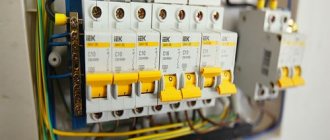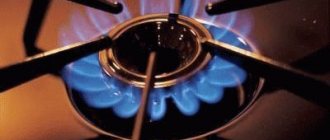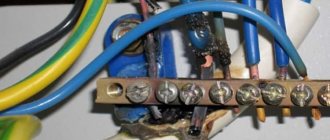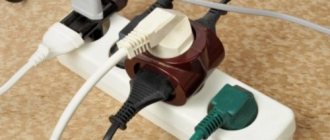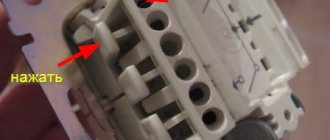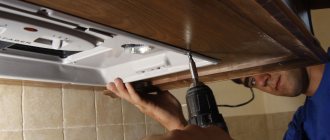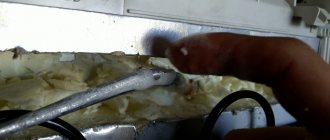Surely most of our readers are familiar with the situation when the electricity goes out at home, but the neighbors are fine with it. First of all, you need to check the circuit breakers installed in the distribution board. Most often, it is their disconnection that causes the home network to lose power. In this article we will talk about why the machine in an apartment or house goes off. The reasons for this phenomenon can be different, and it is important to know them in order to prevent unpleasant consequences associated with failure of electrical appliances or fire of wiring.
Automatic circuit breaker for household power supply - device, purpose, principle of operation
A standard household circuit breaker is a compact rectangular module. On the back of it there is a special groove with a snap mechanism - for mounting on a DIN rail. On the front side there is a switch and information about the operating parameters of the device. In the upper and lower parts there are terminals equipped with screw clamps for fastening the conductors of the home electrical circuit.
Household models have from 1 to 4 pairs of contacts and the corresponding number of poles. Moreover, the scope of their application is directly determined by these parameters. Thus, 2-pole units are installed in a single-phase household network with 220 V at the input, 1-pole units are installed on a separate line, and 3-4-pole units are installed on two-phase circuits designed to operate at 380 V.
The purpose of the device is divided into three main tasks:
- Intentional power off.
This is done manually using a switch on the device body. The function is used when it is necessary to de-energize a separate branch or the entire network of the house in case of repairs, wiring installation and other work that somehow affects the electrical circuit.
Circuit diagram of the circuit breaker Source strojdvor.ru
As all the work is completed, the lever of the device is simply put into working condition. After this, the supply of electricity to the network is restored.
- Automatic shutdown when short circuit occurs.
In this case, the reason why the machine in the panel knocks out is a significant excess of the current in the circuit above the permissible value. A situation arises when a phase and a neutral conductor are connected without load.
As a result, the electromagnetic circuit breaker is instantly activated. In the absence of such a fuse, the electrical wiring, and with it the insulation and all nearby combustible materials, would instantly ignite, which, however, sometimes happens.
- Shutdown in case of overload.
The machine will also turn off when the current consumed significantly exceeds the nominal value. This phenomenon occurs when too many electrical appliances are connected to the network, consuming more electricity than allowed by the electrical circuit.
When the network is overloaded, the machine switches to position “O” Source stroyka-electro.ru
In this case, the opening occurs due to the movement of a heat-sensitive mechanism based on a bimetallic plate. However, unlike the above protective mechanism, this unit does not operate instantly, but as the heating level of the conductor reaches a critical value.
Note! To make sure that during a power outage it was the machine that triggered, you need to inspect it by looking into the distribution panel. When the module is turned off, the tongue of the module is usually directed downwards, and the symbol “O” is visible at its base.
Malfunction of household appliances
If the machine strikes often and at approximately the same period of time, it can be said with a high probability that one of the electrical appliances is faulty. For example, if you notice that the circuit breaker trips when you turn on the washing machine, electric stove or water heater, turn off this equipment and see how the device behaves without electrical appliances. Doesn't work? You need to look for a fault in one of the connected “culprits”. We talked about how to repair household appliances with your own hands in the corresponding section of the site.
You can quickly find faulty equipment using the method of elimination. Disconnect all plugs from the sockets and connect one at a time. On a short-circuited device, the circuit breaker will trip under load.
The main reasons for turning off the machine
There are several main reasons why the machine turns off - these are:
- Congestion.
- The circuit breaker itself is faulty.
- Short circuit.
- Failure of an electrical appliance connected to the circuit.
- Failure of the lighting device.
Short circuit is a common cause of domestic fires Source electroinfo.net
Let us examine in detail the features of each case and ways to solve the problems that arise.
See also: Catalog of companies that specialize in electrical work of any complexity
Overload
Each specific machine has a current rating, for example, 6, 10, 16 amperes, etc., the excess of which causes it to turn off. Therefore, if several devices are simultaneously connected to the network, the total consumer power of which exceeds this value, the network is overloaded and the protective device is triggered.
This situation develops, for example, when the machine is designed for 16 A, and electrical appliances with a total capacity of 18-20 A are immediately connected to the network. As a result, the wiring begins to overload and the metal wires heat up. If the machine does not work, the conductors, like the equipment itself, may overheat, which often leads to ignition and fire.
The problem can be solved in several ways:
- Connecting electrical appliances in order of priority, taking into account the maximum permissible current.
Even the simplest household appliances together can create a large load on the machine Source stihi.ru
- Installation of a more powerful machine. For example, instead of a 16-amp one, a 25A sample is mounted. However, the ability of the wiring to withstand the total power of all devices must be taken into account. For the example given, the optimal copper conductor is a cross-section of 2.5 mm2.
- Replacing all electrical wiring with a more modern and high-quality one. Often, aluminum conductors, unlike copper conductors, heat up faster even at a load that does not reach peak power - which, naturally, will constantly lead to the machine turning off.
Note! During an overload, the machine does not turn off immediately, but as the heat-sensitive elements heat up. This happens the faster, the greater the difference between the exceeded actual power consumption and the rating of the device. In this case, immediately after switching off, the circuit breaker in the panel does not turn on - it will be possible to put the device into working condition only after its fuse has cooled. Typically this takes a few minutes.
Overheating becomes a common cause of machine fire Source ytimg.com
The machine in the control panel does not turn on: apartment, causes of the malfunction and its elimination
When purchasing modern circuit breakers, you need to know that they cannot be repaired, since they are manufactured in a molded case and the parts are not interchangeable. Purchasing new electrical devices is not difficult - they are sold in any hardware store and their cost is very affordable.
How does a circuit breaker work?
Before finding out the main reasons why circuit breakers fail, it is recommended that you familiarize yourself with the structure and operating principle of the unit. The machine includes several electromagnetic disconnectors, thermal disconnectors and power contacts.
The peculiarity of the thermal disconnector is that it operates slowly when the rated current is exceeded. The electromagnetic device is triggered in a fraction of a second when the current is excessive or there is a short circuit.
Main problems
The design includes a small number of parts. Owners of circuit breakers face three main types of breakdowns:
- knocks out;
- does not cock;
- does not turn off.
If the machine regularly knocks out, this may indicate a sudden loss of voltage, or when you turn on a powerful household appliance, one of the circuits is disconnected from the supply line. The machine may also not turn on for the following reasons:
- The wires from the machine were burned off or simply melted.
- The lever does not cock because it is jammed.
- When the lever is cocked, it immediately goes down, the voltage does not appear at all or appears for a short period of time.
All of the above malfunctions require an immediate solution, otherwise the likelihood of a fire increases.
The device crashes for no apparent reason
One of the reasons for the machine being knocked out is power surges.
The machine may regularly turn off due to voltage surges in the supply network or as a result of incorrect operation of the thermal disconnector. The first problem can be eliminated only by a voltage stabilizer mounted at the input to the machine, but this requires large financial costs. The cause of shutdown by the thermal disconnector is a prolonged but insignificant deviation in the value of the rated current.
As a rule, this does not indicate a breakdown of the electrical device, but rather its improper use. For example, if the machine crackles, buzzes or smells unpleasant, it is overloaded. Opening contacts may also be the cause.
To fix the problem, you can try to check the tightness of the wire and, if necessary, remove it to clean the contacts from carbon deposits and oxides, then tighten it again. Without first disassembling the machine, it will not be possible to solve the problem. If it is not possible to carry out the procedure, it is better to purchase a new device.
Trigger when load is turned on
Damaged cable insulation
If the machine does not behave correctly when you turn on a certain household or lighting device, the problem lies in the device itself or the wire leading to the source of the problem. A short circuit occurs as a result of a violation of the integrity of the insulating layer of the cable.
To solve the problem, it is necessary to carry out diagnostics and replace the main line cable with a temporary one. If this helps, you will have to completely check the wiring around the house and upgrade or replace it.
The machine does not turn on
If a person tries to lift the lever and it automatically goes down again, this may indicate the presence of a short circuit or mechanical wear of the working components of the unit. You can verify this quite simply - you should ring the supply phase to zero with an indicator screwdriver or an ohmmeter. To solve the problem, restore the insulating layer or replace the cable; if there is no short circuit, a complete replacement of the equipment will be required.
Lever jammed
There is a problem when you simply cannot move the lever from the lower position. There is only one explanation for this - the contact drive mechanism is jammed. The problem may arise as a result of the device turning off under load or splashes jamming the moving contact, causing a strong arc to form. As a rule, to solve the problem it is necessary to install a new machine.
During a short circuit the machine does not turn off
There are two most common reasons why there is no response to short circuit:
- The electromagnetic disconnector mechanism is jammed or faulty.
- The contacts are stuck as a result of overheating and the formation of arcs when opening.
To fix the problem, you need to install a new machine.
Other Possible Causes
There are also a number of other reasons why the machine in the panel is knocked out once, or it turns off regularly, or does not turn on at all after operation - these are:
- Contact of the grounding conductor with the phase due to incorrect installation of the electrical circuit.
- A powerful electrical discharge from lightning enters the network.
- Wear of the insulating layer, breakdown through microcracks and short-circuiting of old wiring.
- Illiterate installation of the machine.
- Broken contacts in the socket.
Important! Finding the reasons for turning off the machine and correcting malfunctions is only permissible if you have the appropriate experience and knowledge. Inept actions on the part of the repairman are fraught with danger to himself, residents, electrical appliances and the house.
AB is out of order
Well, the rarest reason, which also cannot be excluded, is the poor quality of the machine, which knocks out because it is defective. If you are sure that the wiring and household appliances are intact and there is no overload, check the machine by replacing it with a similar one. We can say with confidence that this will help fix the problem. To avoid such a situation in the future, we recommend that you familiarize yourself with the rating of the best manufacturers of circuit breakers and select one from the list.
Briefly about the main thing
The household circuit breaker has a standard design, a specified number of contact pairs - from 1 to 4, and is installed on a DIN rail in the panel. Its main tasks:
- De-energization by the user of a connected branch or the entire network at home.
- Automatic power cut when overloaded.
- Circuit disconnection due to short circuit.
There are several main reasons why a machine knocks out - overload, short wiring, malfunction of the device itself, short circuit in electrical appliances, breakdown of a lamp, as well as a number of less common ones - lightning strike, improper installation, wear and tear of wiring insulation. It is permissible to identify and eliminate malfunctions only if you have special knowledge and skills, and it is better to entrust this work to an experienced specialist.
Ratings 0
Features of the structure of the electrical distribution panel
Any protective and distribution equipment is placed in special panels. The design features of the shield allow you to control the flow of energy and supply it evenly through all channels.
The electrical panel package includes:
- circuit breakers;
- contactors;
- RCD.
Other components may be present depending on the functionality of the shield.
The machine helps protect electrical wiring from negative consequences. The operating features of the switch are as follows:
- the main task is to protect electrical wiring and household appliances connected to it from excessive current;
- installation must be carried out on a phase circuit, which breaks when the packager is disconnected;
- The switch can de-energize the network when turned off manually and in the event of an emergency.
If an emergency occurs, the machine in the shield is knocked out.
Security measures
When cutting out an electrical panel, you should not climb there yourself, especially without electrical knowledge. First, you need to make sure that the traffic jams are not due to a central power outage, and the problem is only in the apartment. Then it is recommended to turn off all electrical equipment from the network, since at the moment the power supply is restored, when everything is turned on, a power surge will occur, and it can not only break, but also cause a fire.
You might be interested in How to measure voltage
Fire as a result of improper actions
Next, you need to understand what caused it and see which plug worked, turn on the fuse or lift the lever up.
Turning the fuse on
Repeated power outages wear out the electrical switch and result in zero efficiency. Therefore, if the cause was not a central blackout of the meter, it is necessary to eliminate all existing faults, in particular, check the wiring, assess the condition of electrical appliances and lighting devices, and once again calculate the amount of power involved in the network. You can also entrust the troubleshooting of RCD tripping problems to professionals.
The need to contact a service center to avoid problems
A circuit breaker or circuit breaker is a device that guarantees the normal operation of electrical equipment and protects people from short circuits. The device breaks down for various reasons, including due to manufacturing defects. In the event of a breakdown, it is best to contact a service center to avoid unpleasant consequences.
Why does the washing machine knock out the machine?
First of all, in the event of such a failure, many people immediately go to the panel or meter to switch the machine's toggle switch to the on position and continue washing. If the failure is caused by a system overload, such actions are unacceptable - if you turn on the machine yourself during overloads, you risk breaking expensive household appliances.
Important! Experts agree that in such a situation, you need to find the reasons why the plugs or the machine were knocked out, or call an electrician to fix the problem.
If you decide to first find out on your own why the machine knocked out the RCD or plugs, check out the typical reasons that cause such a failure:
- Installation of an unsuitable safety device and breaker.
- Worn or incorrect wiring.
- Short circuit in the power cord of the washing machine.
- Broken socket.
- The network filter has failed.
- Shorting the buttons on the control panel (most often the start key).
- Damage to the SM control module.
- Burnout of terminals and damage to the wiring of an automatic machine.
- Failure of other components: electric motor or heater.
Important! If you have never repaired electrical equipment before, entrust the search for the causes of the breakdown to repairmen (an electrician, a washing machine repairman).
Next, we will consider each of the problems separately.
What to do if the traffic jams are knocked out
If the plugs in your apartment suddenly go out and you don’t know how to turn them on, there is no need to panic, just follow the simple recommendations.
First you need to find out the reasons for the shutdown and understand which part of the circuit has failed. To do this, do the following:
- Check for lighting in all rooms.
- check the voltage in the sockets (use a multimeter, indicator, or any portable electrical device).
- check the equipment that is constantly powered from the network, whether the indicators are on, and so on.
- look out the window. If electricity is lost throughout the area, the problem arose at an electrical substation or there was an accident on a high-voltage line somewhere.
If there is a power outage throughout your area, you will have to wait until the cause of the outage is fixed. If you are the only one without electricity, then everything is much simpler. Take a look at the panel with the machine guns - they may have worked.
